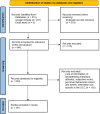Applying the theory of planned behavior to examine breastfeeding determinants in countries of the Gulf Cooperation Council: a systematic review
- PMID: 40448088
- PMCID: PMC12125868
- DOI: 10.1186/s13006-025-00739-z
Applying the theory of planned behavior to examine breastfeeding determinants in countries of the Gulf Cooperation Council: a systematic review
Abstract
Background: Appropriate and timely nutrition during infancy constitutes a critical window of opportunity to ensure proper growth and development. Despite the established benefits of breastfeeding (BF), the proportions of breastfed infants remain disappointingly low in countries of the Gulf Cooperation Council (GCC). Using the Theory of Planned Behavior (TPB), this systematic review aims at examining infant feeding intentions, attitudes, subjective norms, perceived behavioral control and beliefs towards BF amongst women in various countries of the GCC.
Methods: Pertinent data were obtained through a search of peer-reviewed studies published between 2012 and 2024. A total of 12 electronic databases have been searched.
Results: A total of 101 studies were retained. The largest number of studies was from the Kingdom of Saudi-Arabia (80 studies). The results were mapped across the five TPB constructs: intention, subjective norms, attitude, perceived behavioural control and beliefs. Findings showed that, although the intention to BF was high, the intention to exclusively BF was considerably lower. BF was found to align well with the religious norms and social expectations in countries of the GCC. However, factors such as shyness, embarrassment and reticence over BF in public and pumping at work were reported by various studies. There was a negative attitude towards the suitability of BF for working mothers and it was common for women to consider that formula feeding and BF provide equal benefits. Perceived behavior control towards exclusive BF and the sufficiency of breast milk supply was identified as low in several studies, particularly amongst primigravida women and mothers of twins. Women believed that BF in public may expose them to the "evil eye" and that BF may lead to breast sagging.
Conclusions: By identifying opportunities and gaps under each of the TPB constructs, the results of this review may assist in the development of future culture-specific interventions aimed at BF promotion in countries of the region. These include multi-level interventions encompassing the educational system, the media and social media, in addition to community and hospital-based interventions. The results also call for the development of policies tailored to the identified factors in each of the TPB constructs.
Keywords: Attitudes; Beliefs; Breastfeeding; Gulf Cooperation Council; Intentions; Perceived behavioral control; Subjective norms; Systematic review; Theory of planned behavior.
© 2025. The Author(s).
Conflict of interest statement
Declarations. Ethical approval and consent to participate: Not applicable. Consent for publication: Not applicable. Competing interests: The authors declare that the research was conducted in the absence of any commercial or financial relationships that could be construed as a potential conflict of interest. Moreover the authors alone are responsible for the views expressed in this article and they do not necessarily represent the views, decisions or policies of WHO or the other institutions with which the authors are affiliated.
Figures








Similar articles
-
Influence of traditionality and modernity on public breastfeeding behaviors: a theory of planned behavior approach.Int Breastfeed J. 2025 Aug 21;20(1):66. doi: 10.1186/s13006-025-00761-1. Int Breastfeed J. 2025. PMID: 40841677
-
Cup feeding versus other forms of supplemental enteral feeding for newborn infants unable to fully breastfeed.Cochrane Database Syst Rev. 2016 Aug 31;2016(8):CD005092. doi: 10.1002/14651858.CD005092.pub3. Cochrane Database Syst Rev. 2016. PMID: 27577968 Free PMC article.
-
Antenatal breastfeeding education for increasing breastfeeding duration.Cochrane Database Syst Rev. 2016 Dec 6;12(12):CD006425. doi: 10.1002/14651858.CD006425.pub4. Cochrane Database Syst Rev. 2016. PMID: 27922724 Free PMC article.
-
Support for healthy breastfeeding mothers with healthy term babies.Cochrane Database Syst Rev. 2022 Oct 25;10(10):CD001141. doi: 10.1002/14651858.CD001141.pub6. Cochrane Database Syst Rev. 2022. PMID: 36282618 Free PMC article.
-
Cost-effectiveness of using prognostic information to select women with breast cancer for adjuvant systemic therapy.Health Technol Assess. 2006 Sep;10(34):iii-iv, ix-xi, 1-204. doi: 10.3310/hta10340. Health Technol Assess. 2006. PMID: 16959170
References
-
- Shrimpton R, Victora CG, de Onis M, Lima RC, Blossner M, Clugston G. Worldwide timing of growth faltering: implications for nutritional interventions. Pediatrics. 2001;107:e75–75. 10.1542/peds.107.5.e75. - PubMed
-
- Nasreddine L, Zeidan M, Naja F, Hwalla N. Complementary feeding in the MENA region: practices and challenges. Nutr Metab Cardiovasc Dis. 2012;22:793–8. 10.1016/j.numecd.2012.05.010. - PubMed
-
- Jones G, Steketee RW, Black RE, Bhutta ZA, Morris SS. How many child deaths can we prevent this year? Lancet. 2003;362:65–71. 10.1016/S0140-6736(03)13811-1. - PubMed
-
- Khanna SB, Dash K, Swasti DK. Fetal origin of adult disease. JK Sci. 2007;9:206–10. 10.1016/j.cppeds.2011.01.001.
-
- Bernardo H, Cesar V, World Health Organization. Long-term effects of breastfeeding: a systematic review. 2013.
Publication types
MeSH terms
Grants and funding
LinkOut - more resources
Full Text Sources
Medical
Miscellaneous

